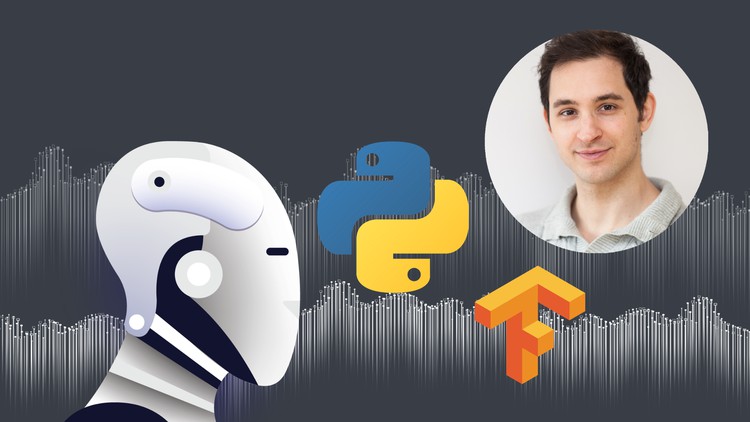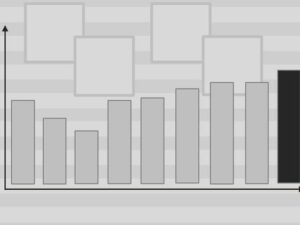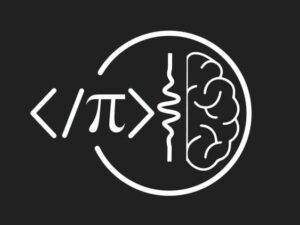Complete 2022 Data Science & Machine Learning Bootcamp
- Descrição
- Currículo
- FAQ
- Revisões
Welcome to the Complete Data Science and Machine Learning Bootcamp, the only course you need to learn Python and get into data science.
At over 40+ hours, this Python course is without a doubt the most comprehensive data science and machine learning course available online. Even if you have zero programming experience, this course will take you from beginner to mastery. Here’s why:
-
The course is taught by the lead instructor at the App Brewery, London’s leading in-person programming bootcamp.
-
In the course, you’ll be learning the latest tools and technologies that are used by data scientists at Google, Amazon, or Netflix.
-
This course doesn’t cut any corners, there are beautiful animated explanation videos and real-world projects to build.
-
The curriculum was developed over a period of three years together with industry professionals, researchers and student testing and feedback.
-
To date, we’ve taught over 200,000 students how to code and many have gone on to change their lives by getting jobs in the industry or starting their own tech startup.
-
You’ll save yourself over $12,000 by enrolling, but get access to the same teaching materials and learn from the same instructor and curriculum as our in-person programming bootcamp.
We’ll take you step-by-step through video tutorials and teach you everything you need to know to succeed as a data scientist and machine learning professional.
The course includes over 40+ hours of HD video tutorials and builds your programming knowledge while solving real-world problems.
In the curriculum, we cover a large number of important data science and machine learning topics, such as:
-
Data Cleaning and Pre-Processing
-
Data Exploration and Visualisation
-
Linear Regression
-
Multivariable Regression
-
Optimisation Algorithms and Gradient Descent
-
Naive Bayes Classification
-
Descriptive Statistics and Probability Theory
-
Neural Networks and Deep Learning
-
Model Evaluation and Analysis
-
Serving a Tensorflow Model
Throughout the course, we cover all the tools used by data scientists and machine learning experts, including:
-
Python 3
-
Tensorflow
-
Pandas
-
Numpy
-
Scikit Learn
-
Keras
-
Matplotlib
-
Seaborn
-
SciPy
-
SymPy
By the end of this course, you will be fluently programming in Python and be ready to tackle any data science project. We’ll be covering all of these Python programming concepts:
-
Data Types and Variables
-
String Manipulation
-
Functions
-
Objects
-
Lists, Tuples and Dictionaries
-
Loops and Iterators
-
Conditionals and Control Flow
-
Generator Functions
-
Context Managers and Name Scoping
-
Error Handling
By working through real-world projects you get to understand the entire workflow of a data scientist which is incredibly valuable to a potential employer.
Sign up today, and look forward to:
-
178+ HD Video Lectures
-
30+ Code Challenges and Exercises
-
Fully Fledged Data Science and Machine Learning Projects
-
Programming Resources and Cheatsheets
-
Our best selling 12 Rules to Learn to Code eBook
-
$12,000+ data science & machine learning bootcamp course materials and curriculum
Don’t just take my word for it, check out what existing students have to say about my courses:
“One of the best courses I have taken. Everything is explained well, concepts are not glossed over. There is reinforcement in the challenges that helps solidify understanding. I’m only half way through but I feel like it is some of the best money I’ve ever spent.” -Robert Vance
“I’ve spent £27,000 on University….. Save some money and buy any course available by Philipp! Great stuff guys.” -Terry Woodward
“This course is amazingly immersive and quite all-inclusive from end-to-end to develop an app! Also gives practicality to apply the lesson straight away and full of fun with bunch of sense of humor, so it’s not boring to follow throughout the whole course. Keep up the good work guys!” – Marvin Septianus
“Great going so far. Like the idea of the quizzes to challenge us as we go along. Explanations are clear and easy to follow” -Lenox James
“Very good explained course. The tasks and challenges are fun to do learn an do! Would recommend it a thousand times.” -Andres Ariza
“I enjoy the step by step method they introduce the topics. Anyone with an interest in programming would be able to follow and program” -Isaac Barnor
“I am learning so much with this course; certainly beats reading older Android Ebooks that are so far out of date; Phillippe is so easy any understandable to learn from. Great Course have recommended to a few people.” -Dale Barnes
“This course has been amazing. Thanks for all the info. I’ll definitely try to put this in use. :)” -Devanshika Ghosh
“Great Narration and explanations. Very interactive lectures which make me keep looking forward to the next tutorial” -Bimal Becks
“English is not my native language but in this video, Phillip has great pronunciation so I don’t have problem even without subtitles :)” -Dreamerx85
“Clear, precise and easy to follow instructions & explanations!” -Andreea Andrei
“An incredible course in a succinct, well-thought-out, easy to understand package. I wish I had purchased this course first.” -Ian
REMEMBER… I’m so confident that you’ll love this course that we’re offering a FULL money back guarantee for 30 days! So it’s a complete no-brainer, sign up today with ZERO risks and EVERYTHING to gain.
So what are you waiting for? Click the buy now button and join the world’s best data science and machine learning course.
-
6Introduction to Linear Regression & Specifying the ProblemVídeo Aula
-
7Gather & Clean the DataVídeo Aula
-
8Explore & Visualise the Data with PythonVídeo Aula
-
9The Intuition behind the Linear Regression ModelVídeo Aula
-
10Analyse and Evaluate the ResultsVídeo Aula
-
11Download the Complete Notebook HereTexto
-
12Join the Student CommunityTexto
-
13Any Feedback on this Section?Texto
-
14Windows Users - Install AnacondaVídeo Aula
-
15Mac Users - Install AnacondaVídeo Aula
-
16Does LSD Make You Better at Maths?Vídeo Aula
-
17Download the 12 Rules to Learn to CodeTexto
-
18[Python] - Variables and TypesVídeo Aula
-
19Python Variable Coding ExerciseQuestionário
-
20[Python] - Lists and ArraysVídeo Aula
-
21Python Lists Coding ExerciseQuestionário
-
22[Python & Pandas] - Dataframes and SeriesVídeo Aula
-
23[Python] - Module ImportsVídeo Aula
-
24[Python] - Functions - Part 1: Defining and Calling FunctionsVídeo Aula
-
25Python Functions Coding Exercise - Part 1Questionário
-
26[Python] - Functions - Part 2: Arguments & ParametersVídeo Aula
-
27Python Functions Coding Exercise - Part 2Questionário
-
28[Python] - Functions - Part 3: Results & Return ValuesVídeo Aula
-
29Python Functions Coding Exercise - Part 3Questionário
-
30[Python] - Objects - Understanding Attributes and MethodsVídeo Aula
-
31How to Make Sense of Python Documentation for Data VisualisationVídeo Aula
-
32Working with Python Objects to Analyse DataVídeo Aula
-
33[Python] - Tips, Code Style and Naming ConventionsVídeo Aula
-
34Download the Complete Notebook HereTexto
-
35Any Feedback on this Section?Texto
-
36What's Coming Up?Vídeo Aula
-
37How a Machine LearnsVídeo Aula
-
38Introduction to Cost FunctionsVídeo Aula
-
39LaTeX Markdown and Generating Data with NumpyVídeo Aula
-
40Understanding the Power Rule & Creating Charts with SubplotsVídeo Aula
-
41[Python] - Loops and the Gradient Descent AlgorithmVídeo Aula
-
42Python Loops Coding ExerciseQuestionário
-
43[Python] - Advanced Functions and the Pitfalls of Optimisation (Part 1)Vídeo Aula
-
44[Python] - Tuples and the Pitfalls of Optimisation (Part 2)Vídeo Aula
-
45Understanding the Learning RateVídeo Aula
-
46How to Create 3-Dimensional ChartsVídeo Aula
-
47Understanding Partial Derivatives and How to use SymPyVídeo Aula
-
48Implementing Batch Gradient Descent with SymPyVídeo Aula
-
49[Python] - Loops and Performance ConsiderationsVídeo Aula
-
50Reshaping and Slicing N-Dimensional ArraysVídeo Aula
-
51Concatenating Numpy ArraysVídeo Aula
-
52Introduction to the Mean Squared Error (MSE)Vídeo Aula
-
53Transposing and Reshaping ArraysVídeo Aula
-
54Implementing a MSE Cost FunctionVídeo Aula
-
55Understanding Nested Loops and Plotting the MSE Function (Part 1)Vídeo Aula
-
56Plotting the Mean Squared Error (MSE) on a Surface (Part 2)Vídeo Aula
-
57Running Gradient Descent with a MSE Cost FunctionVídeo Aula
-
58Visualising the Optimisation on a 3D SurfaceVídeo Aula
-
59Download the Complete Notebook HereTexto
-
60Any Feedback on this Section?Texto
-
61Defining the ProblemVídeo Aula
-
62Gathering the Boston House Price DataVídeo Aula
-
63Clean and Explore the Data (Part 1): Understand the Nature of the DatasetVídeo Aula
-
64Clean and Explore the Data (Part 2): Find Missing ValuesVídeo Aula
-
65Visualising Data (Part 1): Historams, Distributions & OutliersVídeo Aula
-
66Visualising Data (Part 2): Seaborn and Probability Density FunctionsVídeo Aula
-
67Working with Index Data, Pandas Series, and Dummy VariablesVídeo Aula
-
68Understanding Descriptive Statistics: the Mean vs the MedianVídeo Aula
-
69Introduction to Correlation: Understanding Strength & DirectionVídeo Aula
-
70Calculating Correlations and the Problem posed by MulticollinearityVídeo Aula
-
71Visualising Correlations with a HeatmapVídeo Aula
-
72Techniques to Style Scatter PlotsVídeo Aula
-
73A Note for the Next LessonTexto
-
74Working with Seaborn Pairplots & Jupyter Microbenchmarking TechniquesVídeo Aula
-
75Understanding Multivariable RegressionVídeo Aula
-
76How to Shuffle and Split Training & Testing DataVídeo Aula
-
77Running a Multivariable RegressionVídeo Aula
-
78How to Calculate the Model Fit with R-SquaredVídeo Aula
-
79Introduction to Model EvaluationVídeo Aula
-
80Improving the Model by Transforming the DataVídeo Aula
-
81How to Interpret Coefficients using p-Values and Statistical SignificanceVídeo Aula
-
82Understanding VIF & Testing for MulticollinearityVídeo Aula
-
83Model Simplification & Baysian Information CriterionVídeo Aula
-
84How to Analyse and Plot Regression ResidualsVídeo Aula
-
85Residual Analysis (Part 1): Predicted vs Actual ValuesVídeo Aula
-
86Residual Analysis (Part 2): Graphing and Comparing Regression ResidualsVídeo Aula
-
87Making Predictions (Part 1): MSE & R-SquaredVídeo Aula
-
88Making Predictions (Part 2): Standard Deviation, RMSE, and Prediction IntervalsVídeo Aula
-
89Build a Valuation Tool (Part 1): Working with Pandas Series & Numpy ndarraysVídeo Aula
-
90[Python] - Conditional Statements - Build a Valuation Tool (Part 2)Vídeo Aula
-
91Python Conditional Statement Coding ExerciseQuestionário
-
92Build a Valuation Tool (Part 3): Docstrings & Creating your own Python ModuleVídeo Aula
-
93Download the Complete Notebook HereTexto
-
94Any Feedback on this Section?Texto












